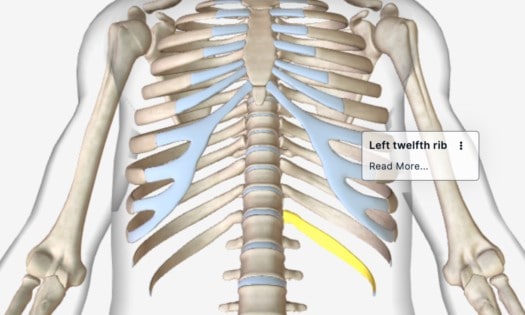How to Put a Rib Back Into Alignment

Dislocated Floating Rib (Floating Rib/ Twelfth rib syndrome)
What are false floating ribs? Floating ribs, as the name implies, means ribs that are floating "in the air" with only one single attachment at the back. Out of the 12 pairs of ribs present in the human rib cage, the 2 pairs are called floating ribs, and these are the 11th and the 12th ribs.
The name "floating" rib is derived from nature which these ribs are connected to the rib cage, it's ONLY connected to the thoracic vertebrae at the back, unlike the other true ribs that are connected both at the thoracic vertebrae at the back, and the sternum to the front.
What is a dislocated floating rib?
Dislocated floating rib( also called false rib) is a condition whereby one of the false floating ribs (either 11th or 12th ribs) is separated or out of place from its normal position at the thoracic vertebrae or spine.
For a better pictorial understanding of the position of the floating ribs in the rib cage, visit here to read about the anatomy of the human rib cage
What is a floating rib syndrome/ twelfth rib syndrome
A floating rib syndrome (or a twelfth rib syndrome) is the condition whereby these immobile false floating ribs starts moving, this movement is often felt on one side of the rib, and is described as having a slipping, popping, or crackling sound.
Dislocated floating rib is one of the major problems related to the human skeletal system.Floating rib injury isn't uncommon as one might think. It actually happens because these lower ribs aren't connected to chest bone and are thus more prone to injury/dislocation.
Causes of dislocated floating ribs
The main cause of a dislocated floating rib is a blunt external force to the chest wall.
On some other occasions, a floating rib dislocation can be caused due to a sudden uncalculated movement, stretch that extends to the lower part of the back, thereby causing the one the false floating ribs to slip or move out of the thoracic vertebrae.
Another danger in regard to rib head out is related to injury of the surrounding tissue. If a patient has been harmed seriously, he will have to be treated surgically along with that rib head treatment.

Dislocated floating rib Symptoms
The number one symptom of a dislocated floating rib is lower-mid back pain, this could be on either side, depending on the location of the rib.
- The general symptoms of ALL rib injuries involve pain and sometimes the contact area gets swollen.
- In a case of a floating rib injury, the area of injury might be swollen, bloodshot, or sometimes even deformed.
- People with a floating rib injury usually complain of a floating rib pain – that is a pain radiating from the floating ribs at the back.
- mild to severe back pain
- Dislocated floating rib pain is usually intense and will increase when pressure is applied or when a person moves this part of the body.
Other symptoms may include:
- Unable to bend to the left or right side.
- Unable to put on socks or shoes without pain.
- Reaching for the floor is painful.
other rib injury symptoms:
Rib dislocation will happen due to the effect of an outside force that is higher than its resistance and firmness of the rib cage. In diagnosis and treatment, medical professionals identify different dislocations with different names, depending on the intensity of the dislocation.
A slipped rib is a situation whereby the rib is said to have a partial dislocation. This happens when the rib slips out of the costal cartilages to which they are connected. A slipping rib isn't a cracked, broken, or dislocated rib, which would pose a much more serious injury that may be life-threatening since the lower ribs can puncture the liver, spleen, or even the kidney.
A floating rib out of place is usually a consequence of intensive strain that happens due to certain types of injuries (as already mentioned), but it can also happen in some other situations. For example, a bone that has become weaker due to age or illness (for example, because of osteoporosis) can dislocate or break even due to a very small, insignificant outside force.
This type of rib head dislocation is called a spontaneous or pathologic fracture. This type of fracture more often happens in the hips of elderly people, whose bones have grown weaker due to several factors such as less movement, a change in the composition of bones related to age, and (sometimes) illness.
There is yet another type of displaced rib fracture that happens due to too much strain or tiredness, which happens in a healthy, normal bone that has been exposed for a long period of time to an abnormally high level of strain.
A popped-out rib or fractured rib injury can be dangerous for two main reasons. The first one is related to the bone itself. If this injury isn't treated or if treatment is postponed, possibly broken pieces of bone can start joining badly (i.e. the bone will not align properly), so in many cases, there will be a need for a surgical procedure to separate the rib and place it properly to align the bone and its parts together.
In a case of a particularly difficult injury, the bone can suffer from infection, which will disrupt the healing process.
Treatment –How to fix a dislocated floating rib
In a case of a situation where afloating rib popped out orfloating rib dislocation occurs, or any type of similar injury that indicates a fractured rib bone, it is important to follow first aid instructions and call a paramedic or ER right away.
Don't give the injured person any food or drinks, as this can postpone treatment – because doctors will have to wait for a few hours before it's safe to give the person general anesthesia.
Any indication of rib head subluxation or other similar types of rib injury that doesn't show spontaneous signs of improvement after several days can very likely be a bone fracture. In this case, the patient should definitely visit a doctor that will most likely check on an X-ray of the extent of the injury.
The first treatment of a dislocated floating rib is the alignment of the bone ends or reposition.
Reposition is an answer to how to fix a rib out of place or an answer to the usual patient's question concerning the first rib subluxation treatment.
Repositioning is done under general anesthesia because it can require tissue opening around the dislocated bone. Additionally, the patient will get medication to prevent infection of the bone or surrounding tissues.
It isn't advisable to pop your rib back in place unless you are a person with medical education.
Another part of treatment post-relocation isrib immobilization, i.e. making sure that the relocated rib will stay in proper position until the joint tissue is attached firmly back again.
This type of immobilization is done with light bandages that are elastic and don't force the injured person to spend time lying in bed all day. However, relaxing and avoiding physical activity is recommended for at least one month, or even longer.
After the rib has been firmly relocated again, i.e. after the recommended period of rest, it will be good to first start with physical therapy.
A professional therapist will show a patient how to exercise their upper body so as to prevent future similar injuries and to maintain the activity of neighboring bones, ribs, and joints. Physical therapy/exercising will prevent swelling and support proper blood flow which will also promote the healing process.
Besides, joint and muscle activity prevents the degenerative process in bones and muscles and joint and bone stiffness. Immobile joints and bones that have been still for more than a month can easily become arthritic.
Floating rib dislocation Home remedies
In a case of rib cartilage injuries, rib head out, first rib out of place, or dislocated floating rib, the most annoying factor is the pain. Pain is a reflection of the body's natural process of healing that can be shorter or longer, but there are some natural remedies that will help with the recovery from painful symptoms of floating ribs popping out.
First of all, all professionals advise the increased consumption of essential fatty acids. The root of the burdock contains a high level of fatty acids that give this plant a strong anti-inflammatory quality. You can eat burdock's root raw, or you can dry it and add it to meals or prepare tea, soup or stew with it.
Turmeric and ginger are also excellent choices because they have a strong anti-inflammatory quality and are very effective against pain. Add them to meals and juices, or brew a tea.
An In-depth Explanation of the Floating Ribs
Floating ribs, as you can see from the picture above are the two lowest ribs on thehuman rib cartilage They are situated on the 11th and the 12th ribs. It derives its name due to the nature of its location and position, it "floats" on its own, that is, it isn't connected to the sternum like the other ribs.
patients with Dislocated Floating rib or the 12th rib syndrome usually described the symptom as a dislocated rib in the back, since these floating ribs', unlike the other ribs, are only connected at the back, which causes the pain to be felt mostly on the back.
The adult human has a skeleton made of over 200 bones that are divided based on their structure into long, short, flat and mixed. Long bones have a central part, body (corpus) and two corners (extremitas): the upper, proximal corner (extremitas proximalis) and lower, distal corner (extremitas distalis).
Bones of the upper body are part of the skeleton that stretches from the base of the skull through the last side of the neck and upper body toward the pelvis bones. The spinal column is made of 33-34 spinal vertebrae that are connected to each other. Vertebrae are separated on 7 neck (vertebrae cervicales), 12 chest (vertebrae thoracicae), 5 hip (vertebrae tumbales), 5 loin(vertebmesacrales) that are together joined into sacrum, and 4 – 5 coccyx ones (verlebrae coccygeae).
Each rib (costa) has a bone part (oscostale) and front of rib cartilage (cartilagocostalis). There are 12 rib pairs; the upper 7 are regularly connected to the chest bone and these are thus calledcostae verae. The lower 5 ribs are called costae spuriae, connected indirectly or not connected to the chest bone at all, and out of these 5, the 11th and 12th are free ribs, scientifically calledcostae fluitantes or, as you might know them, floating ribs.
How to Put a Rib Back Into Alignment
Source: https://dislocatedrib.org/dislocated-floating-rib-treatment/
0 Response to "How to Put a Rib Back Into Alignment"
Post a Comment